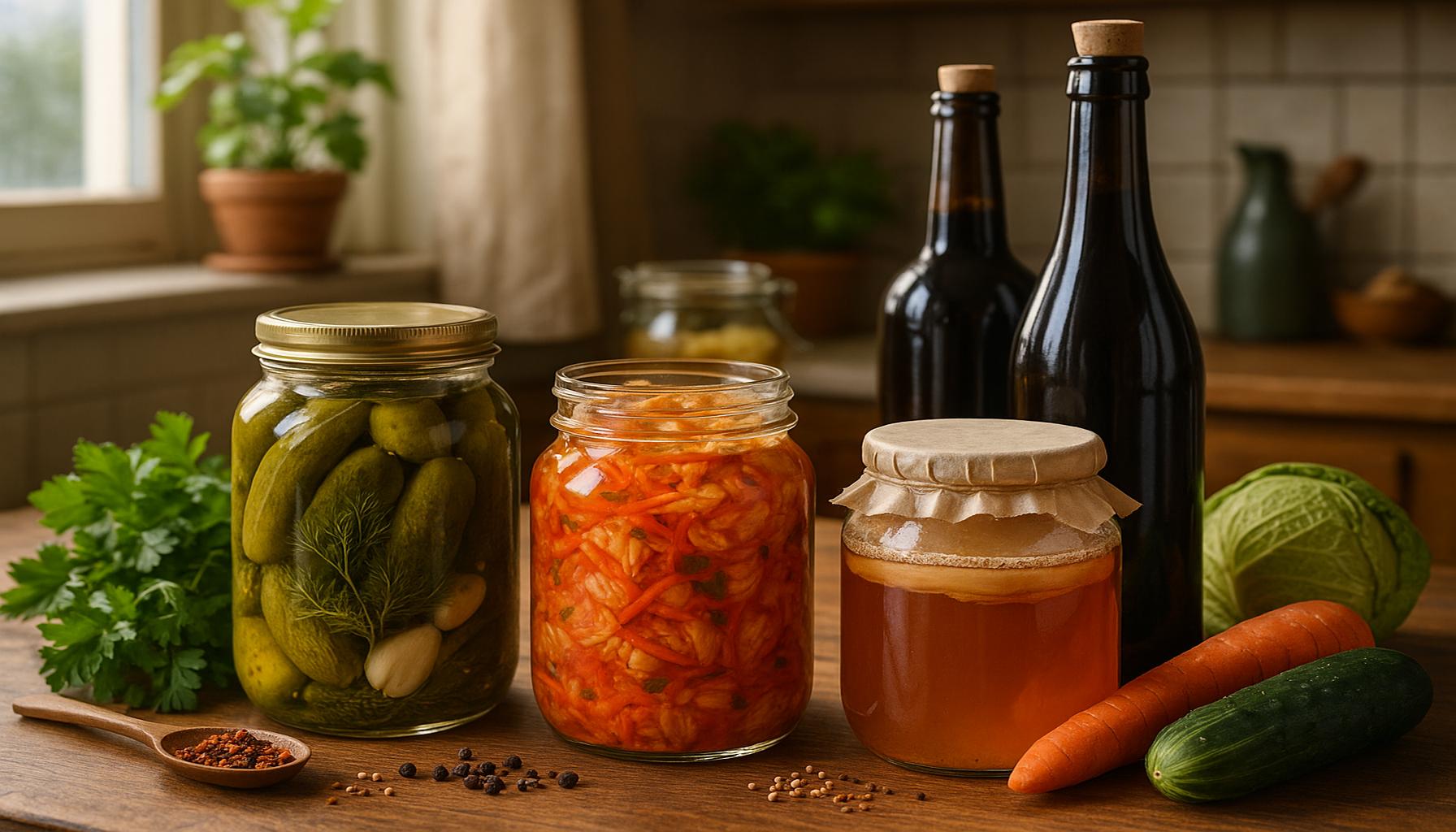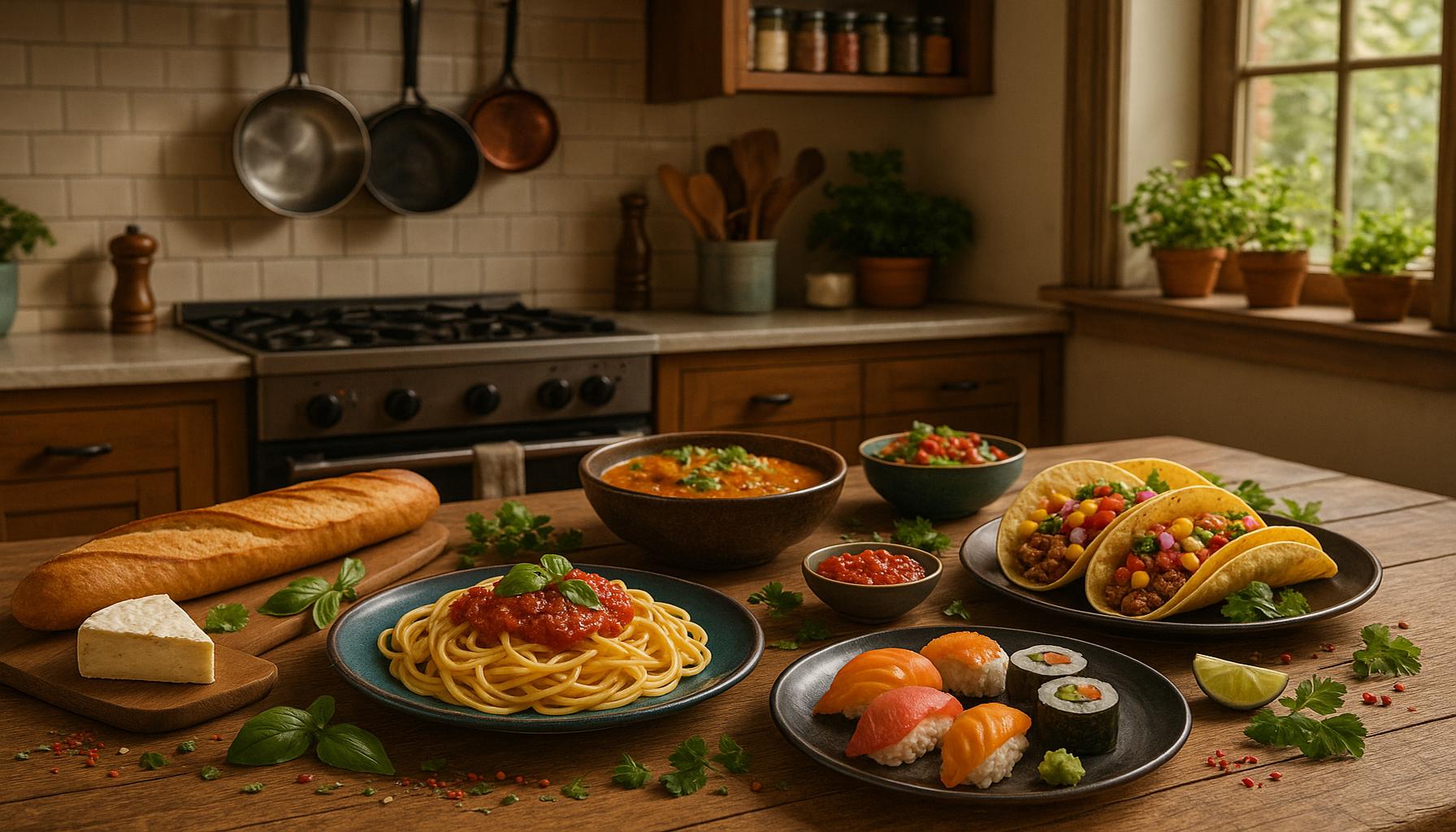Exploring Fermentation: The World of Homemade Fermented Foods and Beverages

Unlocking the Magic of Fermentation
Fermentation is a transformative process that has been integral to the history of food preservation and flavor enhancement across cultures. This ancient technique, employed for thousands of years, not only extends the shelf life of food but also imbues it with a rich array of flavors and nutritional benefits. In the current culinary landscape, a renewed interest in homemade fermented foods and beverages is evident, as more people are eager to explore the depths of this fascinating art. This resurgence might stem from a growing awareness of health trends targeting gut health and wellness, combined with a desire for unique culinary experiences that go beyond the ordinary.
Why Explore Fermentation?
Delving into fermentation reveals numerous advantages that support both health and creativity:
- Boosted Nutrition: Fermented foods, such as yogurt and tempeh, are rich in probiotics—beneficial bacteria that promote a healthy gut microbiome. Studies have shown that these probiotics can aid digestion, strengthen the immune system, and even improve mental health. Foods like kefir, a fermented milk drink, are packed with these good bacteria, making them a popular choice for those looking to enhance their nutritional intake.
- Innovative Flavors: Through the fermentation process, ingredients undergo chemical changes that result in complex flavors. Take kimchi, for example; the combination of napa cabbage and a mix of spices and seasonings develops into a savory delight that adds depth to numerous dishes. This complex flavor profile can elevate simple meals, such as rice bowls or tacos, to gourmet status.
- Creative Freedom: Home fermentation empowers individuals to innovate and experiment with different ingredients and techniques. The process encourages culinary exploration, as one can mix various vegetables, spices, and even fruits to create a personalized fermented delicacy. Imagine crafting your own sauerkraut or experimenting with unusual flavors in a batch of kombucha—the possibilities are endless.
From the simple tang of sauerkraut to the vibrant and spicy kick of kimchi, the variety of fermented foods available is vast and influences many aspects of cooking and eating. Each creation not only nourishes the body but also encapsulates a tradition, bridging generations of culinary practice with the excitement of modern innovation.
Join the Fermentation Journey!
Whether you are a seasoned fermentation aficionado or a curious beginner, there is a wealth of knowledge to be gained from this fascinating process. Resources are abundant, from community workshops to dedicated books and online videos, ensuring that anyone can embark on the adventure of creating delicious fermented foods and beverages at home. Embrace the opportunity to immerse yourself in this sensory journey, where flavors deepen and the health benefits multiply. As you explore fermentation, your taste buds—and your gut—will undoubtedly express their gratitude through joy and increased vitality!
DISCOVER: Click here to enhance your well-being through music
Understanding the Process of Fermentation
At its core, fermentation is a biological process that converts sugars into acids, gases, or alcohol through the action of microorganisms, such as bacteria and yeast. This remarkable transformation not only enriches food but also creates a symbiotic relationship between humans and the microscopic world around us. To better appreciate the art of homemade fermented foods and beverages, it’s essential to grasp the fundamental factors that influence fermentation.
The Fundamentals of Fermentation
There are a few primary elements that contribute to successful fermentation:
- The Role of Microorganisms: Different strains of bacteria and yeast contribute unique flavors and textures to fermented products. Lactobacillus is often the star performer in dairy and vegetable fermentations, while Brettanomyces plays a crucial role in some fruit and grain fermentations, particularly in beer and sourdough bread.
- Sugar Source: Fermentation begins with a carbohydrate source that, when consumed by microorganisms, triggers the conversion process. Common sources include milk sugars in yogurt and lactose, and plant sugars from fruits and vegetables, evident in kimchi and kombucha.
- Environmental Factors: The temperature and pH levels during fermentation affect the microbial growth and the taste of the final product. Most fermentations thrive in mild warmth but may require specific conditions to flourish. For instance, kombucha needs a slightly warm and dark environment, while pickling prefers cooler temperatures to prevent spoilage.
Understanding these factors is the first step toward successful fermentation and paves the way for countless culinary creations. By harnessing the unique characteristics of various microorganisms, home cooks can cultivate a plethora of flavors and aromas, transforming everyday foods into delicious fermented masterpieces.
Essential Homemade Fermented Foods to Try
The world of homemade fermented foods is captivatingly diverse, offering a broad spectrum of options for enthusiasts and novices alike. Here are some popular choices to kickstart your fermentation journey:
- Sauerkraut: A classic example of fermentation, sauerkraut is made by fermenting shredded cabbage with salt. It requires minimal ingredients and time, producing a crisp, tangy dish that pairs well with countless meals.
- Kombucha: A refreshing fermented tea, kombucha has gained immense popularity for its fizzy nature and probiotic content. With a SCOBY (Symbiotic Culture Of Bacteria and Yeast), home brewers can experiment with various flavorings, like fruits and herbs.
- Kefir: Often referred to as a “superfood,” this fermented milk drink is packed with probiotics. Using kefir grains, you can make your own kefir at home, resulting in a creamy, tangy beverage that’s both delicious and nutritious.
- Kimchi: A staple in Korean cuisine, kimchi is a spicy fermented vegetable dish, typically made with napa cabbage and a blend of seasonings. It provides a delightful kick to a meal and is known for its health benefits.
Exploring the myriad of homemade fermented foods opens the door to not just enhanced nutrition, but also creativity in the kitchen. Each venture into fermentation offers the opportunity to discover new flavors, nurture an understanding of food science, and embrace the satisfaction of homemade creations. As we continue on this journey of fermentation, let’s delve deeper into the specific techniques and cultural significance behind these fascinating foods and beverages.
| Category | Details |
|---|---|
| Health Benefits | Homemade fermented foods are rich in probiotics, which strengthen gut health and boost the immune system. |
| Creative Expression | Fermentation allows individuals to experiment with flavors and techniques, leading to unique culinary creations. |
The world of homemade fermented foods and beverages is not only diverse but also incredibly rewarding. With every batch, enthusiasts can explore the intricate balance of flavors that can only be achieved through fermentation. A stronger connection to food is fostered as one watches the transformation of basic ingredients into nutrient-rich delicacies such as kimchi, kefir, or kombucha. Additionally, understanding the science behind fermentation—like how bacteria convert sugars into acids—enhances one’s appreciation for this traditional practice. Fermented foods can be easily tailored to individual tastes, whether through adjusting spices or infusion methods, offering endless opportunities for culinary exploration. As you dive deeper into this fascinating realm, you will uncover historical traditions, nutritional benefits, and the satisfying joy of crafting food and drink that nourishes both body and spirit.
DIVE DEEPER: Click here to learn more
Diving Deeper into Techniques and Applications
Understanding the process of fermentation is only the beginning of a rewarding culinary adventure. Each type of fermented food or beverage comes with its own set of techniques and traditions, reflecting the cultural significance that fermentation holds around the world. While the principles may be similar, the methods and applications vary widely, resulting in a rich tapestry of flavors and practices.
Fermentation Techniques to Master
Achieving mastery in homemade fermentation often involves several techniques, each with its unique approach and requirements. Below are some methods commonly used in various fermented foods:
- Lacto-Fermentation: This technique relies on the naturally occurring lactobacilli found on fruits and vegetables, which thrive in an anaerobic (low-oxygen) environment. This is the primary method for making pickles and sauerkraut. To begin, prepare your vegetables, add salt (which helps draw out moisture and create a brine), and then allow the mixture to sit at room temperature to develop flavor. Experimenting with the fermentation time will yield different levels of tanginess.
- Wild Fermentation: In wild fermentation, natural yeasts and bacteria present in the environment are harnessed to kickstart the fermentation process. This technique is often employed for crafting sourdough bread, where flour and water are combined and left to ferment naturally, cultivating a starter culture rich in flavor. Wild fermentation emphasizes the unique terroir of any given region, varying the final product based on local microbial communities.
- Controlled Fermentation: This method closely monitors temperature and conditions, leading to more predictable outcomes and is commonly used in brewing beer and making kombucha. Home brewers often use specific strains of yeast and cultures to achieve desired flavors and carbonation levels. Ensuring sanitation throughout the process is crucial to avoid any harmful bacteria, making cleanliness an indispensable component of successful brewing.
- Continuous Fermentation: Some processes, such as creating kefir or kombucha, can be scaled into a continuous cycle. With this method, a portion of the finished product is removed regularly, and fresh ingredients are added, allowing for a steady supply of these probiotic-rich beverages. Both kefir and kombucha provide complex flavors that can be further enhanced with additional fruits or herbs, inviting endless creativity.
The Cultural Significance Behind Fermented Foods
Beyond the science of fermentation lies its broader cultural significance. Many societies around the globe have developed unique fermented products that reflect local ingredients and tastes. For instance:
- Miso: In Japan, miso, a fermented soybean paste, has been a dietary staple for centuries. It plays a pivotal role in traditional dishes such as miso soup and is celebrated for its umami flavor and health benefits.
- Tempeh: Originally from Indonesia, tempeh is made by fermenting cooked soybeans with a specific mold. This fermented meat alternative is not only rich in protein but is also deeply woven into the cultural fabric of Indonesian cuisine.
- Fermented Fish: From Scandinavian surströmming (fermented herring) to Korean jeotgal (fermented seafood), the art of fermenting fish has been practiced for preservation purposes and forms part of traditional diets.
- Sourdough Bread: This ancient staple, with origins tracing back thousands of years, serves as a reminder of the intersection of food, culture, and community. The slow fermentation process allows for complex flavors and textures, creating not just bread, but a cultural icon.
As you embark on your own journey of exploration in the world of homemade fermented foods and beverages, you’ll discover that each recipe holds the potential for experiential learning and connection to cultural histories. The adventure of fermentation is as much about storytelling as it is about flavors, making it a truly compelling aspect of culinary tradition.
DISCOVER MORE: Click here to learn about sustainability trends
Conclusion: Embracing the Art of Fermentation
In the fascinating realm of fermentation, homemade foods and beverages offer more than just a delicious treat; they open the door to a world rich in tradition, health benefits, and creative expression. From sauerkraut and kimchi to artisanal beer and probiotic-rich kombucha, the diverse methods of fermentation showcase both cultural significance and the incredible potential of natural processes. As you delve deeper into the techniques—be it lacto-fermentation, wild fermentation, or controlled environments—you’ll gain not only culinary skills but also an appreciation for the stories embedded within your food.
Moreover, each batch of fermented produce acts as a reflection of your environment, knowledge, and imagination. The journey encourages experimentation, allowing you to innovate with flavor combinations, creating vibrant culinary masterpieces that embody your personal tastes. Importantly, this practice taps into the growing interest in sustainable eating and gut health, connecting consumers back to their food source and fostering a greater sense of community.
As you gather your ingredients and embark on this flavorful endeavor, remember that fermentation is as much about process as it is about results. It invites patience and self-discovery, leading to rewards that extend far beyond the dining table. So, whether you are a seasoned home brewer or a curious novice, embrace the adventure of fermentation; each sip and bite will not only tantalize your taste buds but also invite you to share in the age-old traditions that unite us through food and culture.


